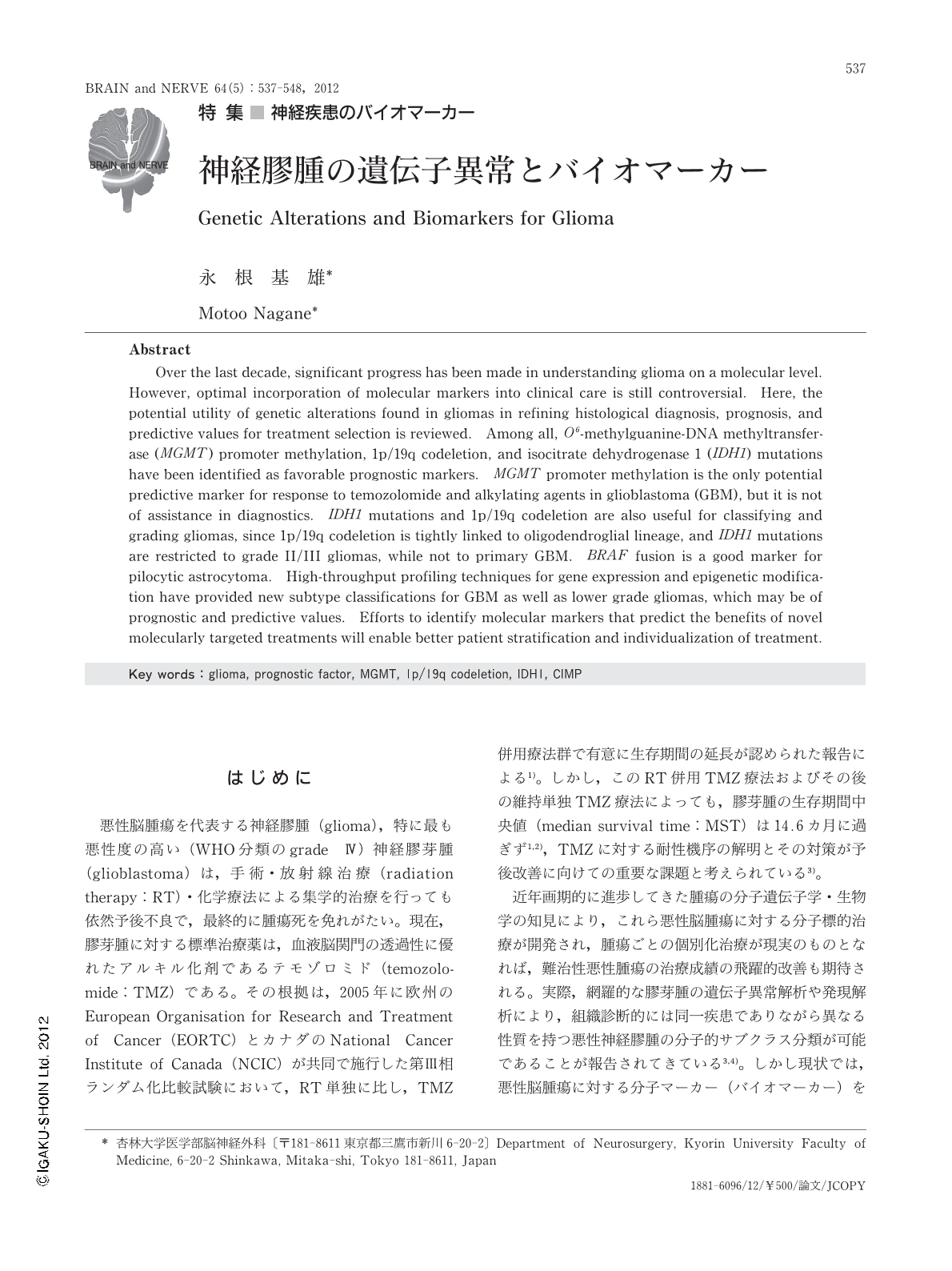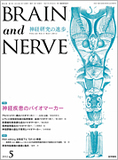Japanese
English
- 有料閲覧
- Abstract 文献概要
- 1ページ目 Look Inside
- 参考文献 Reference
はじめに
悪性脳腫瘍を代表する神経膠腫(glioma),特に最も悪性度の高い(WHO分類のgrade Ⅳ)神経膠芽腫(glioblastoma)は,手術・放射線治療(radiation therapy:RT)・化学療法による集学的治療を行っても依然予後不良で,最終的に腫瘍死を免れがたい。現在,膠芽腫に対する標準治療薬は,血液脳関門の透過性に優れたアルキル化剤であるテモゾロミド(temozolomide:TMZ)である。その根拠は,2005年に欧州のEuropean Organisation for Research and Treatment of Cancer(EORTC)とカナダのNational Cancer Institute of Canada(NCIC)が共同で施行した第Ⅲ相ランダム化比較試験において,RT単独に比し,TMZ併用療法群で有意に生存期間の延長が認められた報告による1)。しかし,このRT併用TMZ療法およびその後の維持単独TMZ療法によっても,膠芽腫の生存期間中央値(median survival time:MST)は14.6カ月に過ぎず1,2),TMZに対する耐性機序の解明とその対策が予後改善に向けての重要な課題と考えられている3)。
近年画期的に進歩してきた腫瘍の分子遺伝子学・生物学の知見により,これら悪性脳腫瘍に対する分子標的治療が開発され,腫瘍ごとの個別化治療が現実のものとなれば,難治性悪性腫瘍の治療成績の飛躍的改善も期待される。実際,網羅的な膠芽腫の遺伝子異常解析や発現解析により,組織診断的には同一疾患でありながら異なる性質を持つ悪性神経膠腫の分子的サブクラス分類が可能であることが報告されてきている3,4)。しかし現状では,悪性脳腫瘍に対する分子マーカー(バイオマーカー)を用いた診断・治療法の選択は,慢性骨髄性白血病におけるBCR-ABL遺伝子や,乳癌におけるHER2遺伝子のような厳密な治療反応性との関連をもって臨床で応用できる段階には至っていない。本稿では,神経膠腫においてこれまで明らかにされてきた遺伝子変異や分子異常の中で,診断,予後や治療効果の予測に関与する可能性のある因子について紹介する。
Abstract
Over the last decade,significant progress has been made in understanding glioma on a molecular level. However,optimal incorporation of molecular markers into clinical care is still controversial. Here,the potential utility of genetic alterations found in gliomas in refining histological diagnosis,prognosis,and predictive values for treatment selection is reviewed. Among all,O6-methylguanine-DNA methyltransferase (MGMT) promoter methylation,1p/19q codeletion,and isocitrate dehydrogenase 1 (IDH1) mutations have been identified as favorable prognostic markers. MGMT promoter methylation is the only potential predictive marker for response to temozolomide and alkylating agents in glioblastoma (GBM),but it is not of assistance in diagnostics. IDH1 mutations and 1p/19q codeletion are also useful for classifying and grading gliomas,since 1p/19q codeletion is tightly linked to oligodendroglial lineage,and IDH1 mutations are restricted to grade II/III gliomas,while not to primary GBM. BRAF fusion is a good marker for pilocytic astrocytoma. High-throughput profiling techniques for gene expression and epigenetic modification have provided new subtype classifications for GBM as well as lower grade gliomas,which may be of prognostic and predictive values. Efforts to identify molecular markers that predict the benefits of novel molecularly targeted treatments will enable better patient stratification and individualization of treatment.

Copyright © 2012, Igaku-Shoin Ltd. All rights reserved.


